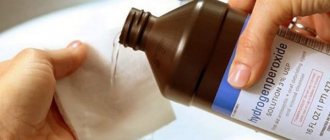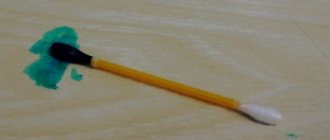The use of potassium salt of permanganate acid, or potassium permanganate, has become widespread in everyday life due to its antiseptic properties. It is used to treat wounds and scratches, remove age spots from the body, and remove calluses and warts. A solution of manganese is used in gynecology for the treatment of the external genitalia. During application, unforeseen situations occur, as a result of which glass containers containing the substance are broken, the solution is spilled, or the powder is scattered. Stains form on hands and clothes that need to be removed. We have to look for something to wash potassium permanganate from the skin.
How to wash off potassium permanganate from skin using folk methods
There are a large number of folk methods for cleansing the skin from potassium permanganate, which are safe, but you must adhere to the recommended dosage.
Alcohol
Take a cotton pad and soak it in ethyl alcohol. Then, applying pressure, begin to scrub the stain. Wash the area with soap and water. This method will not erase everything in one go, so after 10 minutes have passed, repeat the procedure. There should be a lot of alcohol on the disc so that it is absorbed deeply into the skin.
Hydrogen peroxide
Soak a cotton pad in peroxide and apply to the spot on the skin for 15 minutes. Wash everything off with soap and water and repeat the procedure until results are achieved.
Citric acid
Cut a slice of lemon and apply it to your skin for 20 minutes. Then squeeze the citrus juice onto a cotton pad and rub off the potassium permanganate until you achieve the desired result.
Mustard
Pour mustard powder onto your fingers and rub it thoroughly into the stained area. After this, rinse everything off with water. If there are any wounds or scratches on the body, then cover them with an adhesive plaster before the procedure. There is a slight burning sensation during the cleaning process. To prevent your skin from drying out, apply a moisturizer after the procedure.
Pumice
Pumice can only help if there are fresh potassium permanganate stains on the skin. Apply soapy water to the stained area and scrub with a pumice stone.
Clay
Clay can be used in several ways:
- Soak the clay in water and wipe the potassium permanganate stain on your hand.
- We dilute the clay in warm water to form a thick mass. Then we apply it to the stained area, apply a plastic bag and tie it with a bandage for 2-3 hours.
Vinegar
Dilute vinegar with water and soak a cotton pad with it. Wipe the stained area, changing the tampon regularly. After the procedure, wash your skin with soap and water.
Ascorbic acid
Take 2-3 tablets of ascorbic acid and crush them using two spoons. Then pour into a glass of warm water and stir until completely dissolved. Soak a cotton pad or piece of cloth in the solution and wipe the area with potassium permanganate. It will be difficult to completely cleanse the skin using this method.
Laundry soap
If you need to get rid of slightly visible stains of potassium permanganate, then you can use ordinary laundry soap. Rub your palms to warm up and apply soap to them. Then wipe the stained area on your body until completely clean. The process is quite labor-intensive, so it will take a long time to process potassium permanganate stains.
Ammonium sulfide
Moisten a napkin or cotton pad with the substance and thoroughly wipe the stained area of skin. After the procedure, rinse everything off with water and apply moisturizer.
The simplest and most harmless method
There is a fairly widespread myth that potassium permanganate is never washed off the skin with plain water. However, in practice it has been verified that you can get rid of stains without using special products. True, this process will take a lot of time - usually at least a day. If you have so much free time, then simply wash your hands every hour with running water, without using soap. Potassium permanganate dissolves quite well in water, so such repeated exposure can help get rid of its traces on the skin.
How to remove traces of potassium permanganate on the skin using chemicals
Chemical agents are more effective in removing potassium permanganate, but they can harm the surface of the skin. Before use, cover all damaged areas with adhesive tape.
White Spirit
This substance can clean potassium permanganate in a few minutes, but it can only be used on hands. Soak a napkin or cotton pad in the chemical and apply to the stained area. After the procedure, rinse everything off with water and apply moisturizer.
White
The substance is used to bleach clothes and has a high concentration that can cause burns. To use on the skin, make a solution in proportions 5x1, dilute water and bleach, and moisten a cotton pad or napkin with it. After the procedure, wash your skin thoroughly with soapy water.
Sodium hypochlorite
A weakly effective means for cleaning potassium permanganate, but safe to use, since it is used to treat wounds and scratches. Dampen a napkin in it and wipe the stained area of skin.
Chloramine
This chemical quickly damages the skin, so dilute the solution with water in proportions of 10x1. Rub your hands with it and leave to dry for 2-3 minutes. The procedure can be repeated no more than two times in a row.
Recommendations
Before you begin removing potassium permanganate stains, it is recommended to pre-clean your hand skin.
Why is it not washed off with water?
A solution of potassium permanganate interacts with the upper layers of the epithelium. It penetrates into the deep layers and is absorbed very quickly. Therefore, such stains cannot be washed off with water. Over time, the concentration of the substance in the epithelium decreases, and the contaminants disappear. But this process requires 3 – 5 days.
To speed up the disappearance of unpleasant brown areas, it is recommended to use folk remedies and chemical solutions.
Important! With a high concentration of potassium permanganate solution, there is a risk of burns.
Preparing for removal
Before scrubbing contaminated areas of skin, you must thoroughly wash your hands under water using laundry or regular soap. To improve the result, use pumice or a thick sponge. The procedure is repeated until brown water stops flowing from your hands.
How to remove potassium permanganate from clothes
Even the highest concentrates can be used. However, you need to know which product is suitable for your type of fabric, otherwise you can ruin the item forever.
Removing stains with lemon
Squeeze the juice from the lemon into a container and pour portions onto the stained area. Then leave the fabric for 30–40 minutes and rinse with water. The method is not particularly effective, so repeat the procedure until the stain completely disappears.
Using kefir or yogurt
This method is suitable for delicate fabrics. Soak the stain in kefir or yogurt and leave for 5-6 hours. Then we wash everything using the standard method.
Removing stains from clothes with baking soda
Pour baking soda into a container of water and stir to form a paste. We saturate the potassium permanganate stain with it and soak it for 5–6 hours, then wash everything in the washing machine.
How to clean jeans, white T-shirts, bedding
There are several ways to remove potassium permanganate stains from clothes:
- Oxalic acid. In the proportion of 1 tsp. powder per 100 ml of water, mix the ingredients and apply the solution to the stained area. After 30 minutes, rinse the fabric with running water. The method is applicable only for white clothes.
- Ammonia. 1 tbsp. l. We dilute the substances with 180 ml of water. Apply to the stain and wait 15–20 minutes. Then we wash everything in the washing machine. The method can only be used on white clothes.
- Acetic acid and hydrogen peroxide. We soak the fabric in table vinegar and pour hydrogen peroxide on top. The products will react and after a few minutes the potassium permanganate stains will disappear. The method is effective for all types of clothing.
- Sodium hyposulfite. Apply the substance to a cotton pad or napkin and wipe the stained area on the clothing. After the procedure, wash the item in the standard mode.
Most methods are only used on white clothes, so read the instructions for use before removing stains.
Cleaning your fingers
It is especially difficult to wash stains from hands, since manganese stains nails and penetrates the cuticles. If you need to wash off potassium permanganate from the skin of your hands, the best results are achieved using:
- Lemon peel to rub on your nails. The citrus pulp is placed in a small container, where the colored fingertips are placed. This action can be repeated to achieve a positive result.
- Washing powder and detergents. However, a greater effect comes from the use of products containing chlorine. After using this method, the skin becomes dry and tight, so it is recommended to lubricate it with a rich cream or glycerin. This method of removing stains is used extremely rarely.
- Oxalic acid removes both fresh and old stains.
How to clean the floor from potassium permanganate (laminate, linoleum, carpet)
Before using any cleaning product, apply a drop of it to an inconspicuous area of the floor and observe the changes. If the color and structure have not changed, then feel free to apply anywhere.
To clean linoleum or laminate, use alcohol solutions, citric acid, soda and hydrogen peroxide. Do not leave the liquid to soak for a long time, as the substance may be absorbed and change the color of the material. Scrub the floors thoroughly with the solution using a rough sponge, but do not use stiff brushes. At the end of the procedure, wash the floors with water and detergent.
Removing manganese stains from clothing, furniture, and plumbing fixtures
Careless use of a concentrated manganese solution can lead to contamination of clothing, furniture surfaces, and plumbing fixtures. In these cases, laundry soap does not always help, although sometimes its use is quite effective.
Methods for removing potassium permanganate stains from plumbing fixtures:
- Treat the surface with bleach, leave for about 40 minutes, rinse.
- Apply a 10% solution of one of the acids: oxalic, acetic, citric, to the contaminated area, moisten generously, leave for 5 minutes, rinse. If necessary, repeat the procedure.
- Moisten the stain with a solution of equal parts methanol (wood alcohol) and 6%-9% vinegar, rub it and rinse.
- Mix hydrogen peroxide and citric acid (2:1), apply to a fresh (old) stain, leave for about ten minutes, rinse.
- The following composition will help remove potassium permanganate that has not had time to dry: rub laundry soap (200g), add hot water (1 liter) and 100g of baking soda or soda ash. Treat the plumbing, leave for 10 minutes, rinse.
- Add 2 tbsp to the previous composition. spoons of ammonia, cool, add mustard (1.5 tbsp), apply to the dirty area, rinse after 10 minutes.
- Rub dirt on acrylic surfaces with fine sandpaper, then rub this area with a special paste (can be purchased at construction departments).
- The use of Domestos is quite effective on various coatings of bathtubs and sinks.
Removing potassium permanganate from clothing:
- A universal remedy for any fabric: moisten the stain with lemon juice, rub, leave for 10-15 minutes, wash the item.
- For thin fabrics, kefir or yogurt is suitable: soak the contaminated part of the clothing for 6 hours, then wash the product by hand.
- White and light-colored clothing: apply a mixture of water and baking soda to the contaminated area, leave for at least 6 hours, rinse and wash the item.
- Denim: mix hydrogen peroxide with citric acid (1:1), moisten the stain, leave for about 10 minutes, rinse, wash the item.
- The drug Antipyatin can be used according to the instructions for the drug to various types of tissue.
Removing traces of manganese from various surfaces:
- Paper: moisten the stain with water, then treat with bleach, after an hour, remove the liquid with a soft sponge, let the paper dry and, if necessary, iron with a hot iron.
- Floor, dishes: dissolve a piece of crushed laundry soap and a piece of baby soap in a liter of hot water, add soda (2 tbsp) and essential oil (2-3 drops), treat the mark, rinse.
- Solvents are suitable for removing stains on linoleum, wooden floors, and dishes. Before use, check the effect of the product.
- For various floor coverings, you can use Domestos plumbing cleaner, a composition of equal parts hydrogen peroxide and citric acid, taken in equal parts.
https://youtube.com/watch?v=VQzEE6ZODwI
- For upholstered furniture, the same products are suitable as for clothing, a product based on laundry soap (described above), a mixture of equal parts of citric acid and hydrogen peroxide. Apply the product to the stain, rub the stain, and leave for a few minutes. Blot remaining liquid with a towel. Before use, test the effect of the drug on the upholstery fabric in an inconspicuous area.
- To remove stains on a carpet, it is possible to use the listed mixtures for clothing, Vanish for cleaning carpets, Vanish for removing stains.
Any product is more effective if used on fresh stains.
How to remove potassium permanganate from glass
Glass can be washed with bleach, soda and alcohol. If it is a glass jar, then fill it with water and soda solution. Leave for 3-4 hours and rinse with water. Repeat the procedure until completely clean. Alternatively, you can use bleach and undiluted alcohol.
If a window or mirror is smeared, then take one of the above remedies in the correct dosages and a soft sponge. It is more effective to use chemicals, since they have virtually no effect on the glass.
Potassium permanganate is quite difficult to wash off, especially if it concerns skin or delicate clothing, but this can be achieved using the recommendations listed in the article. The main thing is to use the products strictly in accordance with the material, otherwise you may get burns or damage your clothes.
Why are potassium permanganate stains so persistent?
Potassium permanganate is a proven disinfectant. The brightness of its spots is determined by the chemical composition of the substance. It strongly eats into skin, fabric and various surfaces. After just a couple of minutes, the traces oxidize in air and turn brown. Simply washing them off with soapy water will not work. More effective methods are needed.
Potassium permanganate pigments are very durable
Degree of skin injury
In case of chemical injuries, it is important to determine the level of damage, because further actions will depend on this. The classification of burns is as follows:
- First degree. The redness is weak, almost imperceptible swelling and pain;
- Second degree. The swelling becomes more noticeable, the skin takes on a bright red color, and blisters with clear liquid begin to form at the site of the injury, the pain brings considerable discomfort;
- Third degree. Deep tissues are affected, the resulting blisters will be filled with cloudy, dark or bloody fluid;
- Fourth degree. Muscle, bone, fatty tissue, tendons and ligaments are injured.
A burn with potassium permanganate most often acquires the 1st and 2nd level of damage.
Preparatory process
Before you begin removing stains, you need to prepare your skin. To do this, you should completely wash off its traces from the surface of the skin. This will allow the active ingredients of the selected product to come into direct contact with the stain itself.
To begin with, wash your hands under warm running water and soap until the water stops turning its characteristic color. Next you need to use pumice. But in order not to damage the skin, there is no need to vigorously rub the stained area with it.
First aid
The prognosis for treatment of the injury directly depends on the timely provision of first aid to the victim. Providing emergency assistance to a child and an adult differs slightly.
A burn from potassium permanganate on the skin up to the 3rd degree should be washed with running water at room temperature for 25-30 minutes, before removing clothing from the injured area of the body. 1st and 2nd degree burns do not require medical treatment; with proper care they will heal without a trace in 1-3 weeks at home. To prevent mechanical injury to the burned area, you can apply a bandage with panthenol, levomekol, homemade products or anti-burn sprays from the pharmacy. As an antidote, use a slightly alkaline solution consisting of 2 tsp. baking soda and 1 liter of water. After washing, a 3rd degree burn should be covered with a damp cloth (never cotton wool!) and wait for the ambulance to arrive.
Severe 3rd and 4th degree burns are treated only in medical institutions! Traditional recipes are contraindicated.
In case of a chemical burn, eyes should be rinsed with running water for half an hour. After this, rinse with a 5% tannin solution or strong brewed iced tea, and apply drops of antibiotics. Be sure to call an ambulance. The doctor will prescribe further treatment.
For burns of the genital mucosa, first aid consists of copious rinsing with running water and douching with a soda solution (2 tsp per 1 liter of water). Be sure to call a doctor.
First aid for oral poisoning is to remove the chemical from the esophagus and stomach in order to prevent intoxication of the body. Give the victim to drink an alkaline solution of 2 teaspoons of baking soda per 1 liter of water as an antidote. To neutralize manganese, use an aqueous solution of hydrogen peroxide (100 ml per 2 liters of water), repeat the procedure until the contents of the vomit become light-colored and transparent. After washing the stomach and oral cavity, the patient is given castor oil to remove chemical residues through the colon, and activated carbon in a dosage of 1 g per 1 kg of the victim’s weight. Food poisoning should be treated in a hospital under medical supervision.
Due to the fact that the child’s body has more delicate skin, a smaller surface area, and a faster metabolism. The consequences of poisoning for a child will be much more serious than for an adult, even with a lower dosage of the toxic substance. As soon as it is noticed that a child has been poisoned or burned, you need to call an ambulance and begin actions to eliminate the poison from the body. A burn from potassium permanganate in a child should be shown to a doctor if grade 2 severity is suspected. Internal damage will harm the child much more in a short period of time, since the absorption capacity of the stomach and its metabolism are higher, and the circulatory system will spread the poison to the organs and to the brain much faster. This is the danger of poisoning and burns for children. It is much more difficult to cure the consequences due to the immaturity of the organs.











